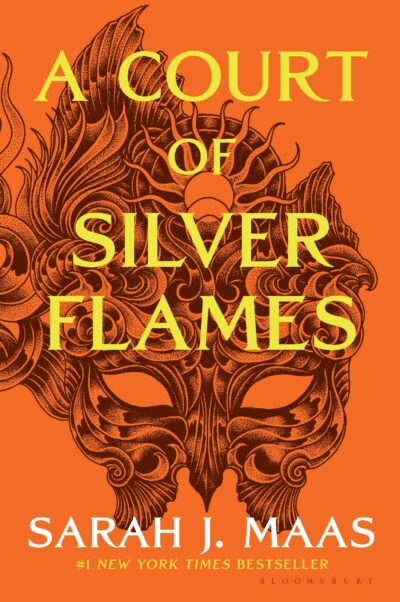
A Court of Silver Flames
Chapter Forty-Five
by J, Maas, SarahThe chapter opens with Nesta, Gwyn, and Emerie enduring a grueling Valkyrie training session under Cassian’s watchful eye. The trio struggles through painful exercises, with Gwyn humorously comparing their ordeal to the legendary toughness of Valkyrie warriors. Cassian, amused by their suffering, reveals he had already tested the exercises himself at dawn, earning a mix of admiration and exasperation from the group. The dynamic between the characters is playful yet competitive, showcasing their camaraderie and shared determination to push their limits.
As the training continues, Cassian unexpectedly asks Nesta what she would name a sword, sparking a lighthearted debate among the group. Gwyn and Emerie offer whimsical suggestions, while Nesta’s blunt response—“Killer”—draws a bemused reaction from Cassian. The conversation hints at a deeper purpose behind his question, though Nesta remains skeptical. The playful banter underscores the growing bond between the characters, even as Nesta senses an underlying tension in Cassian’s persistence.
Later, Cassian reveals the true reason for his question: the blacksmith has crafted three magical blades imbued with Nesta’s power from the Cauldron. These weapons, forged during a previous visit, possess ancient magic unseen for centuries. Cassian explains that Nesta has unknowingly created a new Dread Trove, a revelation that stuns her. However, her shock quickly turns to anger when she realizes that Cassian, Rhys, and Feyre have known about this for some time without telling her.
The chapter ends with Nesta confronting Cassian about the secrecy, her voice sharp with betrayal. Cassian attempts to deflect, but Nesta demands answers, refusing to let the matter drop. The tension between them escalates, leaving their relationship at a precarious point. The scene highlights Nesta’s growing assertiveness and her refusal to be sidelined, setting the stage for further conflict and revelations.
FAQs
1. What Valkyrie training technique does Gwyn reference, and how does Nesta attempt to master it?
Answer:
Gwyn references the Valkyrie mantra, “I am the rock against which the surf crashes,” during a grueling lunge exercise. Nesta attempts to master the physical and mental challenge by focusing on Mind-Stilling techniques—rooting her strength through her toes and concentrating on rhythmic breathing to transcend the pain. The chapter emphasizes her near-success in reaching a calm, detached state, highlighting her growing discipline (pp. 472–473). This reflects the Valkyries’ historical rigor and Nesta’s progression in embracing their warrior ethos.
2. Analyze Cassian’s motivation for asking Nesta to name a sword. How does this reveal a larger conflict in their dynamic?
Answer:
Cassian’s persistent questioning about sword names subtly foreshadows his revelation that Nesta unknowingly imbued three blades with Cauldron-born magic (p. 475). His evasion when pressed—claiming mere “curiosity”—exposes a pattern of withholding information, which Nesta immediately challenges (“Who is ‘we’?”). This tension underscores broader trust issues between Nesta and the Inner Circle, particularly their tendency to control knowledge about her powers, sparking her frustration (pp. 474–475).
3. How does the chapter use physical training as a metaphor for Nesta’s emotional growth?
Answer:
The Valkyrie exercises (e.g., the agonizing lunge hold) mirror Nesta’s internal struggles. Her focus on breathwork and Mind-Stilling parallels her journey toward emotional regulation, while her collapsing “wobbled and burned” legs symbolize vulnerability (p. 473). The shared suffering with Gwyn and Emerie—and their camaraderie in teasing Cassian—reflects her increasing trust in others. The physical endurance thus becomes a tangible measure of her resilience, contrasting her earlier self-destructive tendencies (pp. 472–474).
4. Why is the revelation about the magic weapons significant, and how does Nesta’s reaction deepen the plot’s conflict?
Answer:
The weapons represent a rare resurgence of ancient magic, positioning Nesta as a creator of a new Dread Trove (p. 475). Her shock—”I Made three magic weapons?“—shifts to anger upon realizing Cassian and the Inner Circle concealed this knowledge. Her sharp demand (“How long?”) exposes fractures in their alliance, suggesting future power struggles. This revelation not only expands the lore of Prythian’s magic but also raises stakes about who controls Nesta’s abilities and their consequences (pp. 474–475).
5. Compare Gwyn’s and Emerie’s proposed sword names (“Silver Majesty” vs. “Foe Slayer”). What do these choices reveal about their personalities?
Answer:
Gwyn’s “Silver Majesty” reflects her priestess background—elegant and reverent, possibly inspired by her research on Valkyrie history. Emerie’s pragmatic “Foe Slayer” aligns with her Illyrian warrior upbringing, prioritizing function over flair (p. 474). Their playful debate (“That’s no better!”) highlights their contrasting perspectives while showcasing their camaraderie. Nesta’s blunt preference for “Killer” further contrasts their idealism, emphasizing her no-nonsense approach (p. 474).
Quotes
1. “I am the rock against which the surf crashes. A rock never had to hold a lunge, though.”
This quote captures Gwyn’s humorous yet insightful perspective on the Valkyries’ rigorous training philosophy. It reflects both the physical challenge and the mental discipline required in their warrior training, while also showing the camaraderie between the characters.
2. “When you hammered those blades, you imbued them—the two swords and the dagger—with your power. The Cauldron’s power. They’re now magic blades… You created a new Dread Trove.”
This revelation represents a major turning point in the chapter, revealing Nesta’s unknowing creation of powerful magical weapons. It introduces significant implications for the story’s magical system and Nesta’s growing powers.
3. “Who is ‘we’?… And how long have all of you known about this?”
Nesta’s sharp questioning reveals her growing awareness of being kept in the dark about important matters. This exchange highlights the ongoing tension between her and the inner circle, and her demand for transparency in their relationships.
4. “You’re the one trying to coax a name out of me in the middle of training!”
This outburst shows Nesta’s frustration with Cassian’s poor timing in revealing important information. It encapsulates the chapter’s theme of communication (and miscommunication) between characters, particularly around significant revelations.
